hood release MITSUBISHI OUTLANDER III 2016 Owners Manual
[x] Cancel search | Manufacturer: MITSUBISHI, Model Year: 2016, Model line: OUTLANDER III, Model: MITSUBISHI OUTLANDER III 2016Pages: 464, PDF Size: 60.77 MB
Page 3 of 464
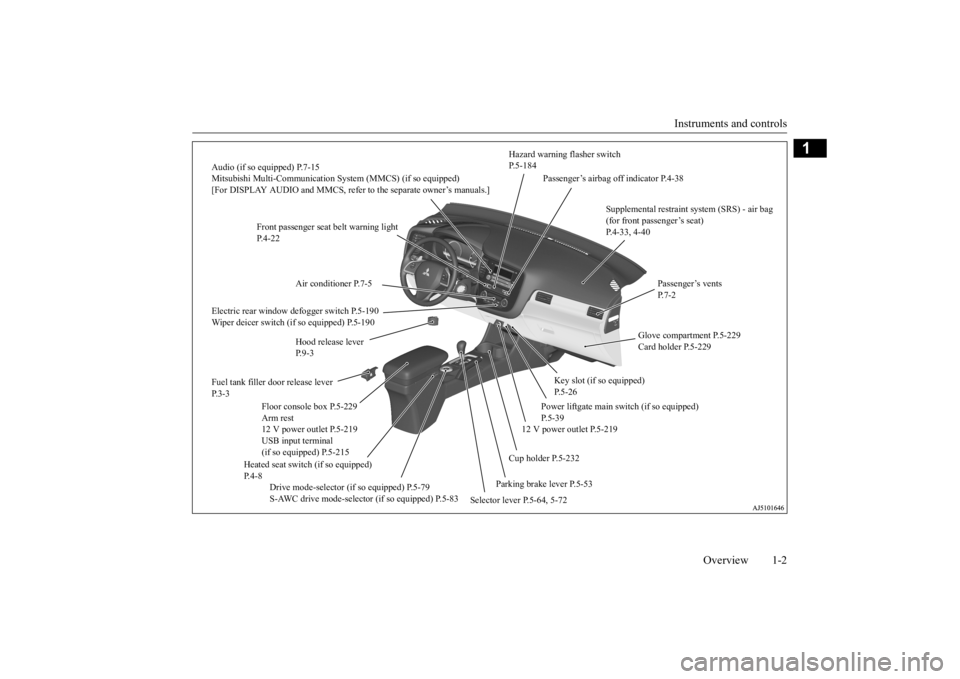
Instruments and controls
Overview 1-2
1
Audio (if so equipped) P.7-15 Mitsubishi Multi-Communication Syst
em (MMCS) (if so equipped)
[For DISPLAY AUDIO and MMCS, refer to the separate owner’s manuals.]
Hazard warning flasher switch P.5-184
Electric rear window defogger switch P.5-190 Wiper deicer switch (if so equipped) P.5-190 Fuel tank filler door release lever P. 3 - 3
Drive mode-selector (if so equipped) P.5-79 S-AWC drive mode-selector (if so equipped) P.5-83
Selector lever P.5-64, 5-72
Parking brake lever P.5-53
Supplemental restraint system (SRS) - air bag (for front passenger’s seat) P.4-33, 4-40
Air conditioner P.7-5 Hood release lever P. 9 - 3
Floor console box P.5-229 Arm rest 12 V power outlet P.5-219 USB input terminal (if so equipped) P.5-215
Heated seat switch (if so equipped) P. 4 - 8
Cup holder P.5-232
12 V power outlet P.5-219
Power liftgate main sw
itch (if so equipped)
P.5-39
Key slot (if so equipped) P.5-26
Glove compartment P.5-229 Card holder P.5-229
Passenger’s vents P. 7 - 2
Passenger’s airbag off indicator P.4-38
Front passenger seat belt warning light P.4-22
BK0223400US.book 2 ページ 2015年2月13日 金曜日 午後12時15分
Page 121 of 464
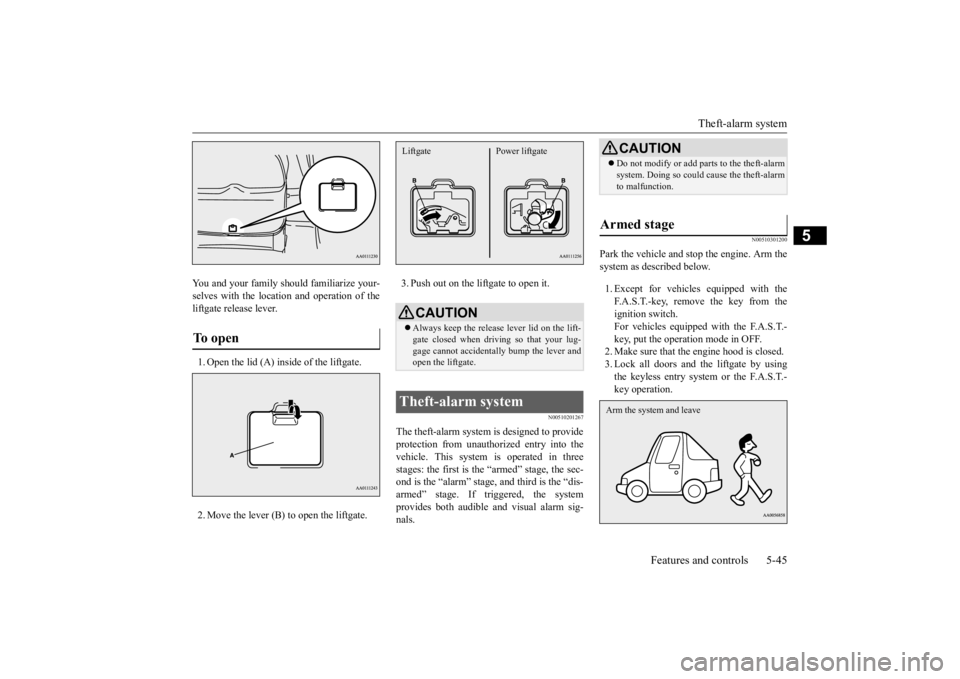
Theft-alarm system
Features and controls 5-45
5
You and your family should familiarize your- selves with the location and operation of theliftgate release lever. 1. Open the lid (A) inside of the liftgate. 2. Move the lever (B) to open the liftgate.
3. Push out on the liftgate to open it.
N00510201267
The theft-alarm system is designed to provide protection from unauthorized entry into the vehicle. This system is operated in three stages: the first is the “armed” stage, the sec-ond is the “alarm” stage,
and third is the “dis-
armed” stage. If triggered, the system provides both audible and visual alarm sig-nals.
N00510301200
Park the vehicle and st
op the engine. Arm the
system as described below. 1. Except for vehicles equipped with the F.A.S.T.-key, remove the key from theignition switch. For vehicles equipped with the F.A.S.T.- key, put the operation mode in OFF.2. Make sure that the engine hood is closed. 3. Lock all doors and the liftgate by using the keyless entry system or the F.A.S.T.-key operation.
To open
CAUTION Always keep the release lever lid on the lift- gate closed when driving so that your lug-gage cannot acci
dentally bump the lever and
open the liftgate.
Theft-alarm system Liftgate Power liftgate
CAUTION Do not modify or add parts to the theft-alarm system. Doing so could
cause the theft-alarm
to malfunction.
Armed stage Arm the system and leave
BK0223400US.book 45 ページ 2015年2月13日 金曜日 午後12時15分
Page 401 of 464
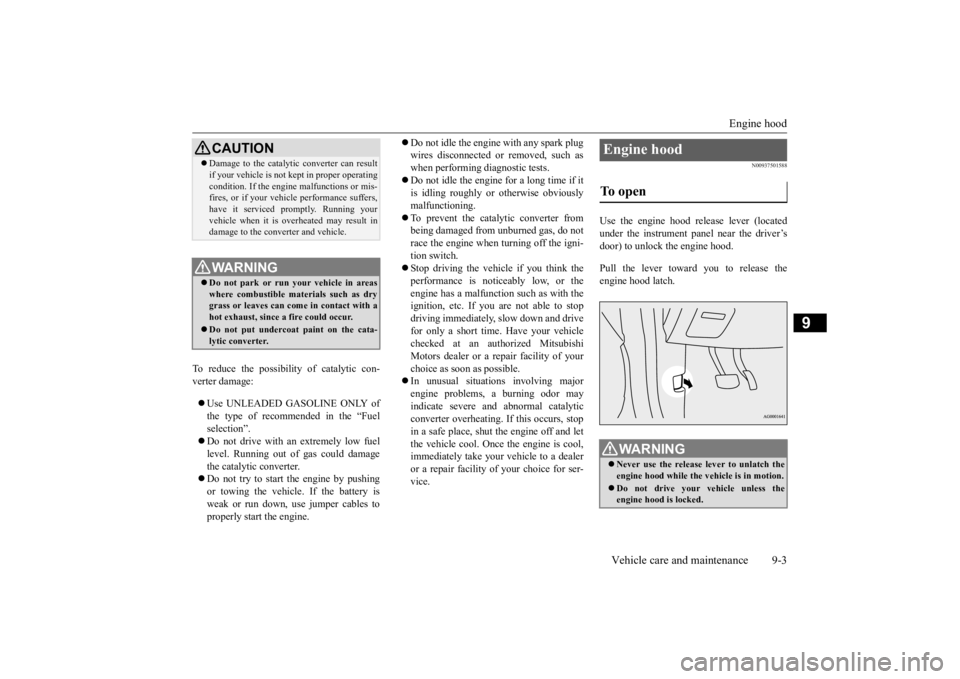
Engine hood
Vehicle care and maintenance 9-3
9
To reduce the possibili
ty of catalytic con-
verter damage: Use UNLEADED GASOLINE ONLY of the type of recommended in the “Fuel selection”. Do not drive with an extremely low fuel level. Running out of gas could damage the catalytic converter. Do not try to start the engine by pushing or towing the vehicle. If the battery is weak or run down, use jumper cables toproperly start the engine.
Do not idle the engine with any spark plug wires disconnected or removed, such aswhen performing
diagnosti
c tests.
Do not idle the engine
for a long time if it
is idling roughly or otherwise obviouslymalfunctioning. To prevent the catalytic converter from being damaged from unburned gas, do notrace the engine when turning off the igni- tion switch. Stop driving the vehicle if you think the performance is noticeably low, or the engine has a malfunction such as with theignition, etc. If you are not able to stop driving immediately,
slow down and drive
for only a short time. Have your vehiclechecked at an authorized Mitsubishi Motors dealer or a repair facility of your choice as soon
as possible.
In unusual situations involving major engine problems, a burning odor may indicate severe and abnormal catalyticconverter overheating.
If this occurs, stop
in a safe place, shut the engine off and let the vehicle cool. Once
the engine is cool,
immediately take your
vehicle to a dealer
or a repair facility of your choice for ser- vice.
N00937501588
Use the engine hood release lever (located under the instrument panel near the driver’s door) to unlock the engine hood. Pull the lever toward you to release the engine hood latch.
CAUTION Damage to the catalyti
c converter can result
if your vehicle is not
kept in proper operating
condition. If the engine
malfunctions or mis-
fires, or if your vehi
cle performance suffers,
have it serviced promptly. Running your vehicle when it is
overheated may result in
damage to the converter and vehicle.WA R N I N G Do not park or run your vehicle in areas where combustible materials such as dry grass or leaves can come
in contact with a
hot exhaust, since a fire could occur. Do not put undercoat paint on the cata- lytic converter.
Engine hood To open
WA R N I N G Never use the release lever to unlatch the engine hood while the
vehicle is in motion.
Do not drive your vehicle unless the engine hood is locked.
BK0223400US.book 3 ページ 2015年2月13日 金曜日 午後12時15分
Page 402 of 464
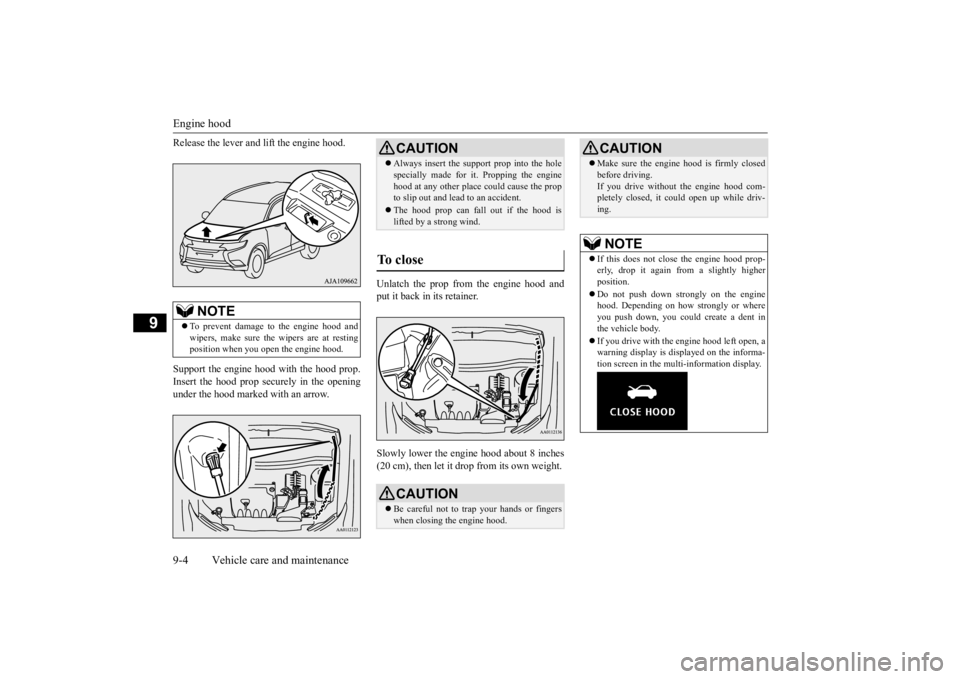
Engine hood 9-4 Vehicle care and maintenance
9
Release the lever and
lift the engine hood.
Support the engine hood with the hood prop. Insert the hood prop securely in the opening under the hood marked with an arrow.
Unlatch the prop from the engine hood and put it back in its retainer. Slowly lower the engine hood about 8 inches (20 cm), then let it drop from its own weight.
NOTE
To prevent damage to the engine hood and wipers, make sure the
wipers are at resting
position when you open the engine hood.
CAUTION Always insert the support prop into the hole specially made for it. Propping the enginehood at any other place
could cause the prop
to slip out and lead
to an accident.
The hood prop can fall out if the hood is lifted by a strong wind.
To close
CAUTION Be careful not to trap your hands or fingers when closing the engine hood.
Make sure the engine hood is firmly closed before driving.If you drive without the engine hood com-pletely closed, it c
ould open up while driv-
ing.NOTE
If this does not clos
e the engine hood prop-
erly, drop it again from a slightly higher position. Do not push down strongly on the engine hood. Depending on how strongly or whereyou push down, you could create a dent in the vehicle body. If you drive with the e
ngine hood left open, a
warning display is displayed on the informa- tion screen in the multi-information display.CAUTION
BK0223400US.book 4 ページ 2015年2月13日 金曜日 午後12時15分
Page 423 of 464
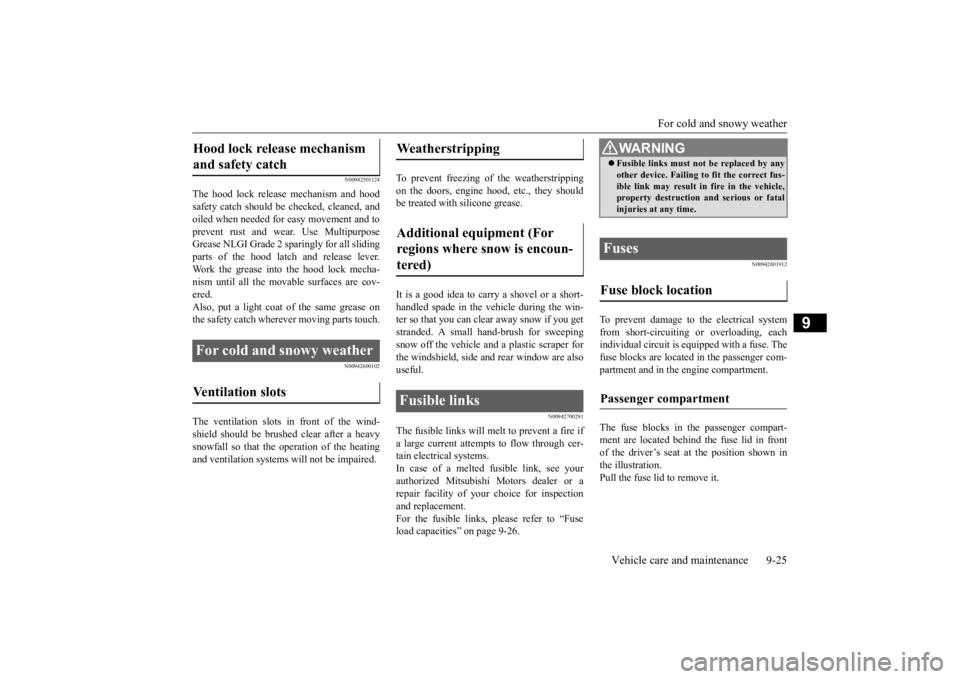
For cold and snowy weather
Vehicle care and maintenance 9-25
9
N00942501124
The hood lock release mechanism and hood safety catch should be
checked, cleaned, and
oiled when needed for easy movement and to prevent rust and wear. Use Multipurpose Grease NLGI Grade 2 sp
aringly for all sliding
parts of the hood latc
h and release lever.
Work the grease into the hood lock mecha- nism until all the mo
vable surfaces are cov-
ered. Also, put a light coat of the same grease onthe safety catch wherever moving parts touch.
N00942600102
The ventilation slots in front of the wind-shield should be brus
hed clear after a heavy
snowfall so that the operation of the heating and ventilation systems
will not be impaired.
To prevent freezing of the weatherstripping on the doors, engine hood, etc., they should be treated with silicone grease. It is a good idea to carry a shovel or a short- handled spade in the vehicle during the win-ter so that you can clear away snow if you get stranded. A small hand-brush for sweeping snow off the vehicle a
nd a plastic scraper for
the windshield, side an
d rear window are also
useful.
N00942700291
The fusible links will melt to prevent a fire ifa large current attempts
to flow through cer-
tain electrical systems.In case of a melted fusible link, see your authorized Mitsubishi Motors dealer or a repair facility of your
choice for inspection
and replacement. For the fusible links, pl
ease refer to “Fuse
load capacities” on page 9-26.
N00942801912
To prevent damage to the electrical systemfrom short-circuiting
or overloading, each
individual circuit is e
quipped with a fuse. The
fuse blocks are located in the passenger com- partment and in the engine compartment. The fuse blocks in the passenger compart- ment are located behind the fuse lid in frontof the driver’s seat at the position shown in the illustration. Pull the fuse lid to remove it.
Hood lock release mechanism and safety catch For cold and snowy weather Ventilation slots
Weatherstripping Additional equipment (For regions where snow is encoun- tered) Fusible links
WA R N I N G Fusible links must not be replaced by any other device. Failing to fit the correct fus-ible link may result in fire in the vehicle,property destruction and serious or fatal injuries at any time.
Fuses Fuse block location Passenger compartment
BK0223400US.book 25 ページ 2015年2月13日 金曜日 午後12時15分
Page 454 of 464
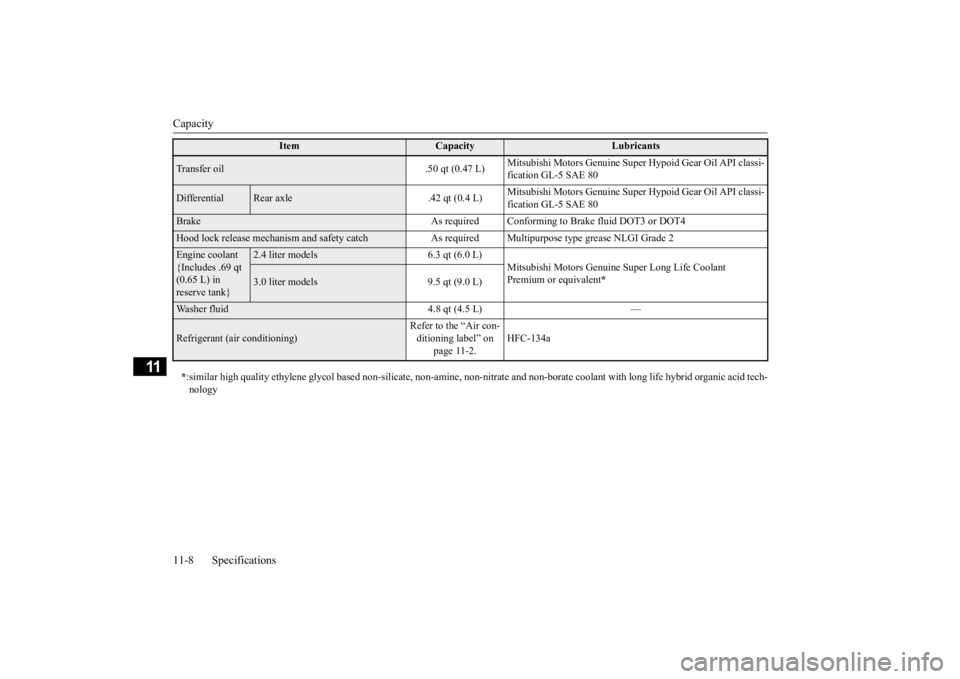
Capacity 11-8 Specifications
11
Transfer oil .50 qt (0.47 L)
Mitsubishi Motors Genuine Supe
r Hypoid Gear Oil API classi-
fication GL-5 SAE 80
Differential
Rear axle .42 qt (0.4 L)
Mitsubishi Motors Genuine Supe
r Hypoid Gear Oil API classi-
fication GL-5 SAE 80
Brake As required Conforming to Brake fluid DOT3 or DOT4Hood lock release mechanism and safety catch A
s required Multipurpose type
grease NLGI Grade 2
Engine coolant {Includes .69 qt (0.65 L) in reserve tank}
2.4 liter models 6.3 qt (6.0 L)
Mitsubishi Motors Genuine
Super Long Life Coolant
Premium or equivalent
*
3.0 liter models 9.5 qt (9.0 L)
Washer fluid 4.8 qt (4.5 L) —Refrigerant (air conditioning)
Refer to the “Air con- ditioning label” on
page 11-2.
HFC-134a
* :similar high quality ethylene
glycol based non-silicate, non-amine, non-nitrate
and non-borate coolant with long life hybrid o
rganic acid tech-
nology
Item
Capacity
Lubricants
BK0223400US.book 8 ページ 2015年2月13日 金曜日 午後12時15分
Page 459 of 464
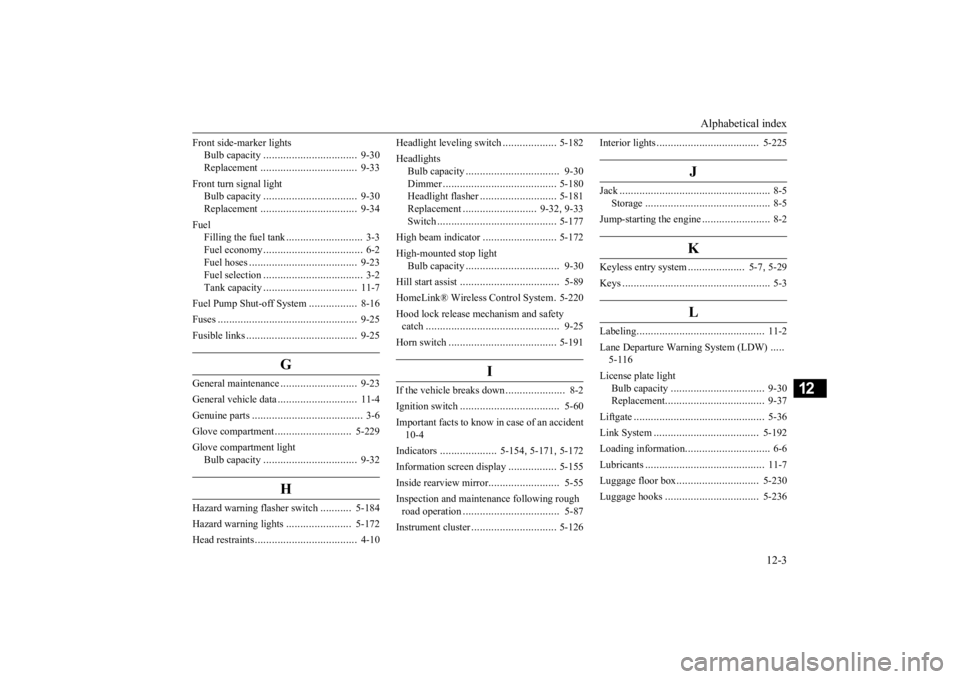
Alphabetical index
12-3
12
Front side-marker lights
Bulb capacity
.................................
9-30
Replacement
..................................
9-33
Front turn signal light
Bulb capacity
.................................
9-30
Replacement
..................................
9-34
Fuel
Filling the fuel tank
...........................
3-3
Fuel economy
...................................
6-2
Fuel hoses
......................................
9-23
Fuel selection
...................................
3-2
Tank capacity
.................................
11-7
Fuel Pump Shut-off System
.................
8-16
Fuses
.................................................
9-25
Fusible links
.......................................
9-25
G
General maintenance
...........................
9-23
General vehicle data
............................
11-4
Genuine parts
.......................................
3-6
Glove compartment
...........................
5-229
Glove compartment light
Bulb capacity
.................................
9-32
H
Hazard warning
flasher switch
...........
5-184
Hazard warning lights
.......................
5-172
Head restraints
....................................
4-10
Headlight leveling switch
...................
5-182
Headlights
Bulb capacity
.................................
9-30
Dimmer
........................................
5-180
Headlight flasher
...........................
5-181
Replacement
..........................
9-32
, 9-33
Switch
..........................................
5-177
High beam indicator
..........................
5-172
High-mounted stop light
Bulb capacity
.................................
9-30
Hill start assist
...................................
5-89
HomeLink® Wireless
Control System
.5-220
Hood lock release me
chanism and safety
catch
...............................................
9-25
Horn switch
......................................
5-191
I
If the vehicle breaks down
.....................
8-2
Ignition switch
...................................
5-60
Important facts to know in
case of an accident
10-4 Indicators
....................
5-154
, 5-171
, 5-172
Information screen display
.................
5-155
Inside rearview mirror
.........................
5-55
Inspection and maintena
nce following rough
road operation
..................................
5-87
Instrument cluster
..............................
5-126
Interior lights
....................................
5-225
J
Jack
.....................................................
8-5
Storage
............................................
8-5
Jump-starting the engine
........................
8-2
K
Keyless entry system
....................
5-7
, 5-29
Keys
....................................................
5-3
L
Labeling
.............................................
11-2
Lane Departure Warning System (LDW)
.....
5-116 License plate light
Bulb capacity
.................................
9-30
Replacement
...................................
9-37
Liftgate
..............................................
5-36
Link System
.....................................
5-192
Loading information
..............................
6-6
Lubricants
..........................................
11-7
Luggage floor box
.............................
5-230
Luggage hooks
.................................
5-236
BK0223400US.book 3 ページ 2015年2月13日 金曜日 午後12時15分